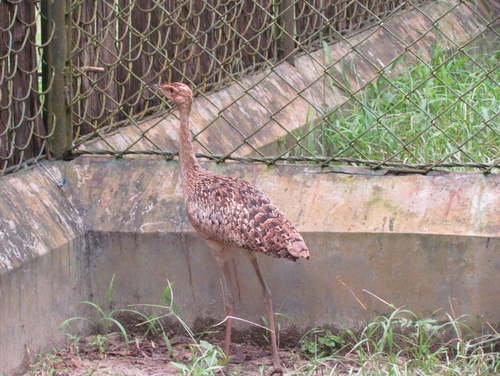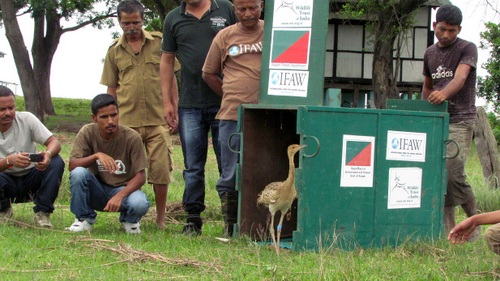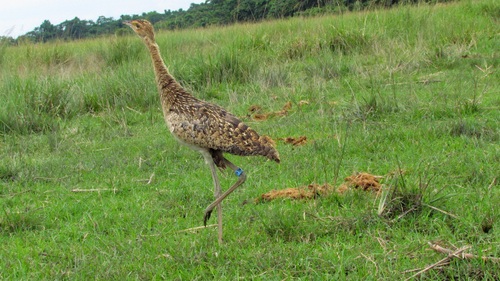Critically Endangered Bengal Florican rescued and released in Assam
Kaziranga, August 21, 2014: The International Fund for Animal Welfare-Wildlife Trust of India (IFAW-WTI) run Centre for Wildlife Rehabilitation and Conservation (CWRC) tended to its first case of an injured Bengal florican recently, after the bird had been picked up by locals and taken for worshiping.
“We got a call on Sunday night from a local NGO- Naturalist for Rehabilitation of Snakes and Birds (NRSB)- telling us that a female Bengal florican had been taken by some villagers to their house. They had never seen such a bird before and thought she was a gift from the Gods. They had set her up in their room and were worshipping her. We went over immediately and got the bird to CWRC, after informing the Forest Department,” said Dr Panjit Basumatary, IFAW-WTI veterinarian.
According to Dr Panjit, the injuries, which were minor, were probably caused when the locals were handling the bird after they found her near human habitation at Lakhipur. The 10-12 year old florican was determined fit to go back to the wild and in the wee hours of Tuesday morning, after consultation with the State Forest Department, was released in the Mihimukh area of the Kohora Range of Kaziranga National Park, an established florican habitat.
According to the IUCN Red list, Bengal florican (Houbaropsis bengalensis) is a Critically Endangered bustard with a “very small, declining population; a trend that has recently become extremely rapid and is predicted to continue in the near future, largely as a result of the widespread and on-going conversion of its grassland habitat for agriculture.” The global population is estimated to be around 250-999 mature individuals (350-1,500 individuals), with an approximate 300-400 individuals estimated in India.
“With just a few hundred Bengal floricans left in the wild in India, they are at a greater risk of extinction than tigers, rhinos and elephants. Being shy and habitat centric birds, they don’t adapt easily and are generally not found near dwellings. As more and more of their habitat is being cut, this species will not be able to survive for long,” said Dr NVK Ashraf, Chief Veterinary Officer, WTI.
The Bengal floricon distribution across India ranges from the terai grasslands of Uttar Pradesh to Assam and Arunachal Pradesh in India through Nepal, as well as Cambodia. Within India, the Bengal florican survives in highly fragmented numbers in Manas National Park, Kaziranga National Park, Orang National Park, Sonai-Rupai Wildlife Sanctuary, Dibru-Saikhoa National Park and Burachapori Wildlife Sanctuary in Assam, D’Ering Wildlife Sanctuary in Arunachal Pradesh, Jaldapara and Gorumara Wildlife Sanctuary in West Bengal and Dudwa National Park in Uttar Pradesh.











